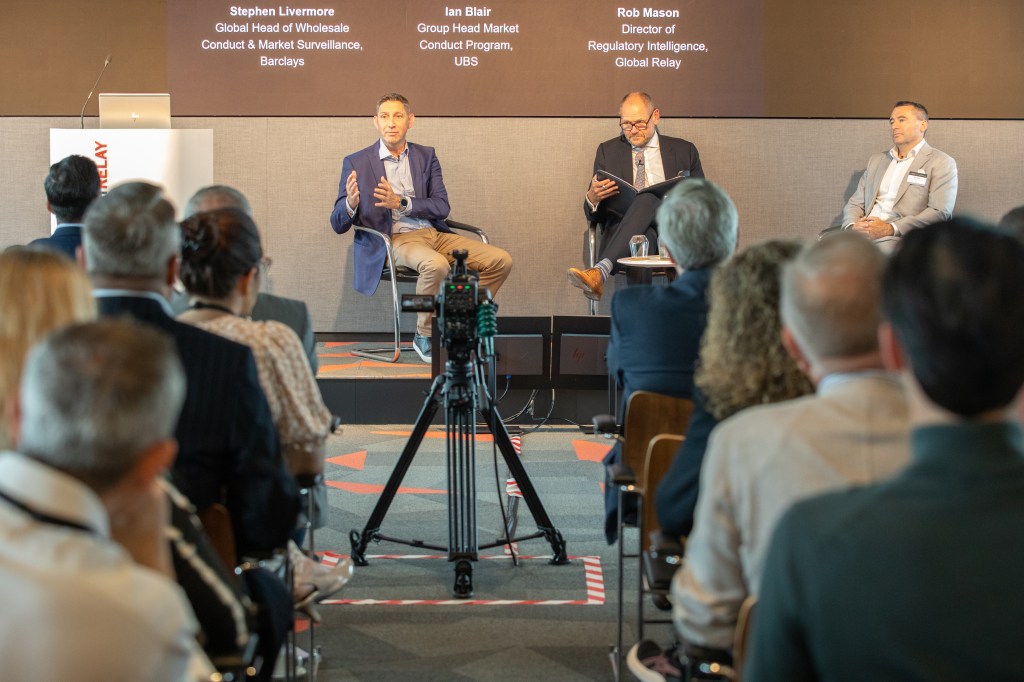Stephen Livermore and Ian Blair joined Rob Mason for a discussion at Global Relay’s recent summer gathering in London on why surveillance was currently subject to such focus. Livermore is Global Head of Wholesale Conduct & Market Surveillance at Barclays and Blair Group Head of the Market Conduct Program at UBS. Mason is Global Relay’s Director of Regulatory Intelligence. Over a hundred industry professionals were in the audience.
Mason opened up by asking: “Why are all eyes on surveillance?” Blair felt that: “Surveillance professionals should be acting as influencers”, using enterprise-wide surveillance data to ensure that the firm’s board-level is informed of the requirements to remain compliant with industry regulations.
He felt the control functions in the firm should also “get the data that they need” and ensure the records are kept in a compliant way. And he said it was important to evidence that everything “is done on a full-time risk-based and proportionate perspective: what you don’t surveil is as important as what you do surveil.”
He emphasized two points:
- The firm is responsible for archiving data; and
- Surveillance is responsible for influencing and ensuring that the surveillance of the data is risk-based, proportionate and fully traceable.
Sooner or later, all conversations of this kind come around to resources, and Mason asked if the cost of surveillance was a manageable one.
“Banks don’t want to see mega-million dollar fines coming from regulators in order to get banks to take action.”
Stephen Livermore, Global Head of Wholesale Conduct & Market Surveillance, Barclays
Livermore responded: “Banks are always going to have a desire to operate in the most cost-effective way. Banks don’t want to see mega-million dollar fines coming from regulators in order to get banks to take action.
So, he said: “It’s our job to win the hearts and minds and to ensure understanding of those stakeholders that we’re working with, to express the important value of Surveillance and the value-add that we can bring, the importance of the program that we run, beyond just reviewing alerts. Banks should invest in Surveillance and see the benefit of putting pennies on the table over a longer period of time rather than writing a massive check once every decade.”
Livermore said: “If you have a compelling business case to justify investment, it will receive appropriate consideration (everybody is competing for the same dollars), clearly those that are generating income within the firm are going to get preference.”
Status of surveillance
The head of surveillance role has matured, Mason said, and asked if the pair saw a time when the head of surveillance is an FCA-controlled function, similar to an SMF16?
Livermore said: “I think it makes a lot of sense and the increasing focus on Surveillance is leading us in that direction.”
And he added, “historically it has often depended on the relationship that you’re able to build within your organization as to how much significance has been placed on surveillance. Some organizations see surveillance as easy, ‘an admin task, so offshore it and make it as cheap as possible’. This is a mistake in my view and I commend those that see the value in funding and resourcing Surveillance appropriately to do it properly.”
He acknowledged that it takes time to build relationships and win over stakeholders internally and that “sticking an SMF badge on your forehead possibly gets you there a little bit faster.”
“Are we going to use AI to catch bad guys? Yes we will. Will we do it in the next 12 months? No.”
Stephen Livermore, Global Head of Wholesale Conduct & Market Surveillance, Barclays
Mason said it was notable that the head of surveillance role now had a higher profile, but observed that when it came to recordkeeping, “there isn’t a risk appetite, you have to capture everything.” However, with surveillance, “due to the budget and resource constraints and to a degree, the regulation, it means you simply can’t cover absolutely everything. Brave decisions need to be made.” So, he asked: “How do you make judgments?”
Blair thought that: “Governance needs to be integrated and fully connected across the lines of defense, the control functions, in particular, the first line where you need senior folk at the table at a regular degree of cadence across first lines as well.” In short, he thought: “You have to understand the issues around risk to assess it.” And this requires proper documentation.
AI and social media
No discussion about surveillance would be complete without mention of AI, and Mason was keen to hear what the duo thought about the influence it would have, especially in light of recent research by Global Relay that found only 42% of respondents plan to introduce AI into their workflows in the next 12 months.
In general, the panel agreed that AI will become an important tool but it won’t take over in the next 12 months. Using the machine learning elements of AI will help to reduce the number of false positives, and it can make the “grunge work” more efficient so more time can be spent on surveillance. As Livermore put it: “Are we going to use AI to catch bad guys? Yes we will. Will we do it in the next 12 months? No.”
Blair warned that: “AI is not a panacea, it’s a slow burner” but also acknowledged “it’s a very exciting time to be in surveillance, but proceed with caution! We need the right people and the right skill sets to understand the risks.”
Livermore agreed, but expressed a worry that surveillance people weren’t as involved as they should be at this stage.
“Governance needs to be integrated and fully connected across the lines of defence.”
Ian Blair, Group Head of the Market Conduct Program, UBS
Use of social media at work remains a burning issue, and Mason asked Blair and Livermore how concerned they were about it.
Blair noted that firms will have digital governance in place, usually in the corporate communications function. This function also does its own surveillance of employees and social media sites. There are compliant ways of using the likes of LinkedIn, through the firm’s own infrastructure and following the policies and protocols and guidelines around that. He explained that the surveillance in place “is not from a conduct perspective but more from following the policy if you will.”
Blair’s advice on social media:
- Communications policies need to be very clear on what you can and can’t do.
- Training must be rolled out to all of the staff and within that, possibly attestations harvested from staff.
- Technology must be provided so employees can communicate compliantly with clients.
- If clients want to use WhatsApp, staff need to know how they are able to do that compliantly, and companies need to make sure they can record and surveil those messages.
- Make sure you can evidence that you have firm disciplinary processes in place and you can evidence transgressions.
AI transcription and translation services
Mason moved on to the development of large language models, asking if the pair thought people were needed in different locations who speak local dialects. It was acknowledged that the capabilities of transcription and translation services have greatly improved. However, as Blair explained: “What it doesn’t do is understand the nuances of the question.” He thought voice transcription services should sit alongside native-language people who surveil.
Livermore agreed, saying: “You don’t have to have armies of people, but you might still want those one or two.” This would allow surveillance teams to be “more dynamic with their resource planning.” He was firmly of the belief that “Having native speakers gives a higher quality of review.”
Mason concluded by asking: “If you were given a blank canvas rather than an inherited program, what would you do differently at the outset?”
“If you want to be able to create careers, you want to be able to enthuse and inspire people, you want them to be able to understand what they’re doing is a good thing.”
Ian Blair, Group Head of the Market Conduct Program, UBS
Blair said: “First and foremost, I would want to look at the skill sets that we have within the function and sit down and design the roles that we need to ensure we have an equal ability to generate the right alert.”
To do this, he thought the following was needed.
- Have people who are able to understand the risks of the business.
- Make sure that we have individuals who are linked into understanding the nuances of the data versus positioning perspective.
- Have people who understand what controls need to be in place, where it flows from the providers either via the venues on the front office systems or due to our own surveillance systems.
- Make sure that we have enough skill sets to be able to understand how to work within the mobile governance structures of the future.
- Have the ability to effectively tune and calibrate those alerts above the line, and below the line using more mathematical and statistical scientific approaches to ensure that when the alert is finally generated.
He finished by saying that “if you want to be able to create careers, you want to be able to enthuse and inspire people, you want them to be able to understand what they’re doing is a good thing.”
One audience member asked: “How many data scientists should there be in a surveillance team in a big bank as opposed to people who are markets and compliance experts? And how do you get the best out of data scientists?”
Livermore said it was really important to ensure that you have data scientists working on the creation of the surveillance system itself. “Look at the patterns of the alerts and where they’re alerting, whether they’re coming across some business areas or certain behaviors and then you can start to look to see what kind of eligible data you can put on top of that, including using tools like AI detection.”
He foresaw a significant increase in the number of data professionals working in the area. “It is probably a 90:10 ratio at the moment with data scientist being the lower figure,” he said, but expressed the hope that in the future the data scientist and the surveillance SME will be able to think and deliver on both parts of the analysis.

















